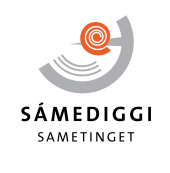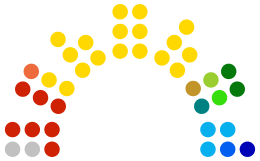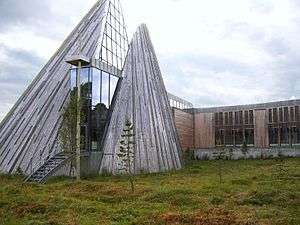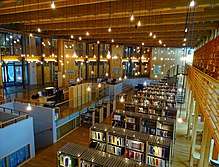Sami Parliament of Norway
Coordinates: 69°28′14.24″N 25°29′45.62″E / 69.4706222°N 25.4960056°E
| Sami Parliament of Norway Northern Sami: Sámediggi Lule Sami: Sámedigge Southern Sami: Saemiedigkie Skolt Sami: Sääʹmteʹǧǧ Norwegian: Sametinget | |
|---|---|
| 8th Sami Parliamentary Assembly | |
 | |
| Type | |
| Type | |
| History | |
| Founded | 9 October 1989 |
| Preceded by | Norwegian Sami Council |
| Leadership | |
Speaker | |
Deputy speaker | |
President of the Sami Parliament | |
| Structure | |
| Seats | 39 |
 | |
Political groups |
Governing council (23)
Other opposition (9)
|
| Elections | |
|
Open list proportional representation Modified Sainte-Laguë method | |
Last election | 11 September 2017 |
Next election | 2021 |
| Meeting place | |
|
| |
|
Sami Parliament of Norway Building Karasjok, Norway | |
| Website | |
|
www | |
| Footnotes | |
|
1Member of Sami Parliament Elisabeth Erke announced on 7 May 2018 that she would resign from the Labour Party and serve as a non-affiliated member of the Sami Parliament. On 21 august 2018, the sami newspaper Ságat reported that Erke had joined the Centre Party and was henceforth a part of the coalition. 2Member of Sami Parliament Kåre Olli announced on 12 June 2018 that he would resign from the Labour Party and serve as a non-affiliated member of the Sami Parliament. | |
.jpg)

The Sami Parliament of Norway (Norwegian: Sametinget, Northern Sami: Sámediggi, Lule Sami: Sámedigge, Southern Sami: Saemiedigkie, Skolt Sami: Sääʹmteʹǧǧ) is the representative body for people of Sami heritage in Norway. It acts as an institution of cultural autonomy for the indigenous Sami people.
The Parliament was opened on 9 October 1989. The seat is in the village of Kárášjohka (Karasjok) in Kárášjohka Municipality in Finnmark county. It currently has 39 representatives, who are elected every four years by direct vote from 7 constituencies. The last election was in 2017. Unlike in Finland, the 7 constituencies cover all of Norway. The current president is Aili Keskitalo who represents the Norwegian Sami Association.
History
.jpg)
In 1964, the Norwegian Sami Council was established to address Sami matters. The members of the body were appointed by state authorities. This body was replaced by the Sami Parliament.
In 1978, the Norwegian Water Resources and Energy Directorate published a plan that called for the construction of a dam and hydroelectric power plant that would create an artificial lake and inundate the Sami village of Máze. This plan was met by strong opposition from the Sami, and resulted in the Alta controversy. As a result of the controversy, the Norwegian government held meetings in 1980 and 1981 with a Sami delegation appointed by the Norwegian Sami Association, the Sami Reindeer Herders’ Association of Norway and the Norwegian Sami Council. The meetings resulted in the establishment of a committee to discuss Sami cultural issues, and the Sami Rights Committee addressing Sami legal relations. The latter proposed a democratically elected body for the Samis, resulting in the Sami Act of 1987. In addition, the Sami Rights Committee resulted in the 1988 amendment of the Norwegian Constitution, and the adoption of the Finnmark Act in 2005.[1]
.jpg)
The Sami Act (1987:56), stipulating the responsibilities and powers of the Norwegian Sami Parliament, was passed by the Norwegian Parliament on 12 June 1987 and took effect on 24 February 1989. The first session of the Sami Parliament was convened on 9 October 1989 and was opened by King Olav V.
Organization

The Norwegian Sami Parliament plenary (dievasčoahkkin) has 39 representatives elected by direct vote from 7 constituencies. The plenary is the highest body in the Sami Parliament and it is sovereign in the execution of the Sami Parliaments duties within the framework of the Sami Act. The representatives from the largest party (or from a collaboration of parties) form a governing council (Sámediggeráđi), and selects a president. Although the position of vice-president was formally removed from the Sami Parliament's Rules of Procedure in 2013, it is considered the concern of the President of the Sami Parliament whether he or she wants to appoint a vice-president. The governing council is responsible for executing the roles and responsibilities of the parliament between plenary meetings. In addition there are multiple thematic committees addressing specific cases.[2]
Presidents
| President | Term | Party |
|---|---|---|
| Ole Henrik Magga | 1989–1993 | Norwegian Sami Association |
| Ole Henrik Magga | 1993–1997 | Norwegian Sami Association |
| Sven-Roald Nystø | 1997–2001 | Norwegian Sami Association |
| Sven-Roald Nystø | 2001–2005 | Norwegian Sami Association |
| Aili Keskitalo | 2005–2007 | Norwegian Sami Association |
| Egil Olli | 2007–2009 | Labour Party |
| Egil Olli | 2009–2013 | Labour Party |
| Aili Keskitalo | 2013–2016 | Norwegian Sami Association |
| Vibeke Larsen | 2016–2017 | Non-affiliated |
| Aili Keskitalo | 2017–present | Norwegian Sami Association |
Location

The Sami Parliament of Norway is located in Karasjok (Kárášjohka), and the building was inaugurated on 2 November 2000. There are also offices in Guovdageaidnu (Kautokeino), Unjárga (Nesseby), Gáivuotna (Kåfjord), Divtasvuodna (Tysfjord), and Snåase (Snåsa).
The town of Kárášjohka is considered an important center of Sami culture in Norway. Approximately 80% of the town's population is Sami-speaking, and the town also hosts Sami broadcasting stations and several public and private Sami institutions such as the Sami Museum and the Sami chamber of commerce (Sami Trade and Industry).[3][4]
Building
The building was designed by the architects Stein Halvorsen & Christian Sundby, who won the Norwegian government's call for projects in 1995, and inaugurated in 2005. The government called for a building such that “the Sami Parliament appears in a dignified way” and “reflects Sami architecture.” Hence the peaked structure of the Plenary Assembly Hall resembles the tipis the Sami used as a nomadic culture. The parliament building also houses a Sami library focussing on books in the Sami language or on Sami topics, and the Sami chamber of commerce, 'Sami Trade and Industry'.[5][6]
Responsibilities
The parliament works with political issues it considers relevant or of interest to the Sami people. The responsibilities of the Sami Parliament in Norway are: "(1) to serve as the Samis’ elected political body to promote political initiatives and (2) to carry out the administrative tasks delegated from national authorities or by law to the Sami Parliament.".[2]
The extent of responsibility that was assigned and transferred from the Norwegian government at the time of establishment was modest (1989). However, more responsibilities have been added including:[7]
- Management of the Sami Development Fund, which is used for grants to Sami organizations and Sami duodji (1989).
- Responsibility for the development of the Sami language in Norway, including allocation of funds to Sami language municipalities and counties (1992).
- Responsibility for Sami culture, including a fund from the Norwegian Council for Cultural Affairs (1993).
- Protection of Sami cultural heritage sites (1994).
- Development of Sami teaching aids, including allocation of grants for this purpose (2000).
- Election of 50% of the members to the board in the Finnmark Estate (2006).

One of the responsibilities is ensuring that the section 1–5 of the Saami Act (1987:56) is upheld, i.e., that the Sami languages and Norwegian continue to have the same status. A good example of this is the current situation in Tysfjord, where speakers of Lule Sami cannot conduct their official business in that language as the municipality has not provided anyone who can speak it to assist them. This is the only municipality in Norway where speakers of that language should theoretically be able to speak it with officials, but this has not come to fruition; therefore, the Sami Parliament must fight for this cause with Tysfjord and must bring it to the attention of the Norwegian Government, if Tysfjord fails to rectify the situation.
Finances
Funding
Funding is granted by the Norwegian state over various national budget lines. But the parliament can distribute the received funds according to its own priorities. In the Norwegian government the main responsibility for Sami affairs, including the allocation of funds, is the Ministry of Labour and Social Inclusion.[2]
The total budget for the Norwegian Sami Parliament has been about:
- 2016: 464 million NOK.[8]
- 2008: 311 million NOK.[9]
- 2007: 275 million NOK (ibid).
- 2006: 260 million NOK.
In addition the parliament controls "Samefolkets fond", a fund established in 2000 as a compensation for the government's previous policy of "Norwegianizing" the Sami population.
Salaries and other expenses
None of the MPs receive salaries.
Elections
To be eligible to vote or be elected to the Norwegian Sami Parliament a person needs to be included in the Sami census. In order to be included the following criteria must be met as stipulated in Section 2–6 of the Sami Act: "Everyone who declares that they consider themselves to be Sami, and who either has Sami as his or her home language, or has or has had a parent, grandparent or great-grandparent with Sami as his or her home language, or who is a child of someone who is or has been registered in the Sami census, has the right to be enrolled in the Sami census in the municipality of residence." [2] Results of the last election:
| Parties | Votes | % | +/− | Seats | +/− | |
|---|---|---|---|---|---|---|
| Norwegian Labour Party (Norgga Bargiidbellodat, Det norske Arbeiderparti) |
2,534 | 26.8 | −5.0 | 14 | −4 | |
| Norwegian Sami Association (Norgga Sámiid Riikkasearvi, Norske Samers Riksforbund, NSR) |
1,986 | 21.0 | −5.3 | 11 | −5 | |
| Árja | 949 | 10.0 | – | 3 | – | |
| Progress Party (Ovddádusbellodat, Fremskrittspartiet) | 737 | 7.8 | +5.5 | 3 | +3 | |
| Centre Party (Guovddásbellodat, Senterpartiet) | 466 | 4.9 | −1.8 | 0 | −1 | |
| Conservative Party (Olgesbellodat, Høyre) | 439 | 4.6 | +2.2 | 1 | +1 | |
| Kautokeino reindeer herders list (Johttisápmelaccaid listu, Kautokeino flyttsameliste) |
411 | 4.4 | − | 2 | − | |
| Norwegian Sami National Association and Sami People joint list (Norgga Sámiid Riikkasearvvi ja Sámeálbmot Bellodaga oktasaslista, NSR felles) |
366 | 3.9 | − | 2 | − | |
| Sami League of Nation (Sámiid Álbmotlihttu, Samenes Folkeforbund) |
297 | 3.1 | −1.8 | 0 | 0 | |
| Sami People's Party (Samefolkets parti) | 221 | 2.3 | −1.5 | 0 | −1 | |
| Sami residents in Southern Norway (Sámit Mátta/Lulli-Norggas, Samer bosatt i Sør-Norge) |
191 | 2.0 | +0.2 | 1 | 0 | |
| Nordkalottfolket | 184 | 1.9 | − | 1 | – | |
| Åarjel-Saemiej Gielh (ÅaSG) | 146 | 1.5 | − | 1 | – | |
| Non-reindeer herders list (Dáloniid Listu, Fastboendes Liste) |
124 | 1.3 | − | 0 | − | |
| Common list (Oktasaslista, Felleslista) | 110 | 1.2 | − | 0 | − | |
| Ofelas | 75 | 0.8 | − | 0 | − | |
| Socialist Left Party (Sosialistalas Gurutbellodat, Sosialistisk Venstreparti) |
64 | 0.7 | −2.8 | 0 | 0 | |
| Sjaddo | 55 | 0.6 | − | 0 | − | |
| Christian Democratic Party (Kristelig Folkeparti) | 48 | 0.5 | − | 0 | − | |
| Liberal Party (Gurutbellodat, Venstre) | 45 | 0.5 | −0.2 | 0 | 0 | |
| 9,448 | 100% | 39 | ||||
Cooperation with the state government
.jpg)
In the Norwegian central administration the coordinating organ and central administrator for Sami issues is the Department of Sami and Minority Affairs in the Ministry of Labour and Social Inclusion. This department also coordinates interministerial and Nordic state cooperation regarding Sami issues. The Sami Parliament is consulted when state government issues affect Sami interests.[10]
See also
References
- ↑ http://www.galdu.org/govat/doc/eng_damning.pdf
- 1 2 3 4 http://www.un.org/esa/socdev/unpfii/documents/2016/NGO-Indigenous/Sami-Parliament-of-Norway-eng.pdf
- ↑ The town with the Sami Parliament, Cristian Uluru, 2006.
- ↑ See the Wikipedia article on Kárášjohka.
- ↑ Parliament for the Sami people / SH arkitekter, on the Modern Architectural Concepts blog, consulted 3 November 2010
- ↑ Norway’s Sami Parliament: Getting to 50-50 Archived 2011-07-28 at the Wayback Machine., on the International Museum of Women website, consulted 3 November 2010.
- ↑ http://www.galdu.org/govat/doc/eng_samediggi_adm.pdf
- ↑ Budget for 2016
- ↑ 49,1 millioner mer til samiske formål - NRK Sámi Radio - NRK
- ↑ http://www.galdu.org/govat/doc/eng_sami_issues.pdf
External links
| Wikimedia Commons has media related to Sami Parliament of Norway. |
On gender balance in the parliament:
- Norway’s Sámi Parliament: Getting to 50-50, on the International Museum of Women website